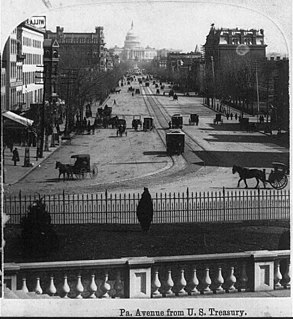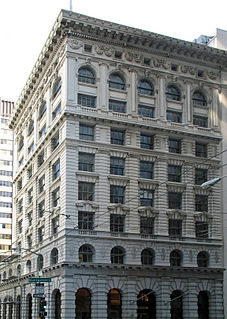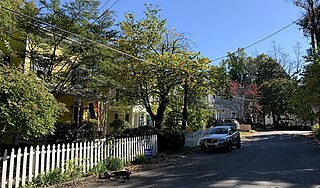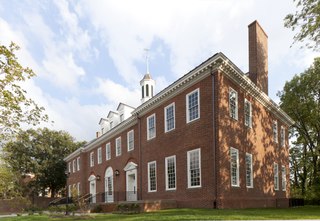
Chillum is an unincorporated area in Prince George's County, Maryland, United States, bordering Washington, D.C. and Montgomery County.

Georgetown is a historic neighborhood and commercial and entertainment district located in Northwest Washington, D.C., situated along the Potomac River. Founded in 1751 in the Province of Maryland, the port of Georgetown predated the establishment of the federal district and the City of Washington by 40 years. Georgetown remained a separate municipality until 1871 when the United States Congress created a new consolidated government for the whole District of Columbia. A separate act, passed in 1895, specifically repealed Georgetown's remaining local ordinances and renamed Georgetown's streets to conform with those in the City of Washington.

Riggs Bank was a bank headquartered in Washington, D.C. For most of its history, it was the largest bank headquartered in that city. On May 13, 2005, after the exposure of several money laundering scandals, the bank was acquired by PNC Financial Services.

Downtown Pittsburgh, colloquially referred to as the Golden Triangle, and officially the Central Business District, is the urban downtown center of Pittsburgh. It is located at the confluence of the Allegheny River and the Monongahela River whose joining forms the Ohio River. The "triangle" is bounded by the two rivers. The area features offices for major corporations such as PNC Bank, U.S. Steel, PPG, Bank of New York Mellon, Heinz, Federated Investors and Alcoa. It is where the fortunes of such industrial barons as Andrew Carnegie, Henry Clay Frick, Henry J. Heinz, Andrew Mellon and George Westinghouse were made. It contains the site where the French fort, Fort Duquesne, once stood.

William Wilson Corcoran was an American banker, philanthropist, and art collector. He founded the Corcoran Gallery of Art.

PNC Financial Services Group, Inc. is an American bank holding company and financial services corporation based in Pittsburgh, Pennsylvania. Its banking subsidiary, PNC Bank, operates in 27 states and the District of Columbia, with 2,945 branches and 9,051 ATMs. The company also provides financial services such as asset management, wealth management, estate planning, loan servicing, and information processing. PNC is one of the largest Small Business Administration lenders and one of the largest credit card issuers. It also provides asset-based lending to private equity firms and middle market companies. PNC operates one of the largest treasury management businesses and the second largest lead arranger of asset-based loan syndications in the United States. Harris Williams & Co., a subsidiary of the company, is one of the country's largest mergers and acquisitions advisory firms for middle-market companies. Midland Loan Services, a division of PNC Real Estate based in Overland Park, Kansas and founded in 1991, is ranked by Mortgage Bankers Association as the 2nd largest master and primary servicer of commercial bank and savings institution loans.

The U Street Corridor, sometimes called Cardozo/Shaw or Cardozo, is a commercial and residential district in Northwest Washington, D.C., most of which also constitutes the Greater U Street Historic District. It is centered along a nine-block stretch of U Street from 9th to 18th Streets, which from the 1920s until the 1960s was the city's black entertainment hub, called "Black Broadway" and "the heart of black culture in Washington, D.C.". After a period of decline following the 1968 riots, the economy picked up with the 1991 opening of the U Street Metro station. Subsequent gentrification diversified the population, which is 67% non-Hispanic White and 18% African American. Since 2013, thousands of residents have moved into new luxury apartment buildings. U Street is now promoted as a "happening" neighborhood for upscale, "hip", and "eclectic" dining and shopping, its live music and nightlife, as well as one of the most significant African American heritage districts in the country.

Healy Hall is a National Historic Landmark and the flagship building of the main campus of Georgetown University in Washington, D.C. Constructed between 1877 and 1879, the hall was designed by Paul J. Pelz and John L. Smithmeyer, prominent architects who also built the Library of Congress. The structure was named after Patrick Francis Healy, who was the President of Georgetown University at the time.

The Washington and Georgetown Railroad Company was the first streetcar company to operate in Washington, D.C. It was incorporated and started operations in 1862, using horse-drawn cars on tracks between Georgetown and the Navy Yard. Two additional lines ran on 7th Street NW/SW and 14th Street NW. In 1890, it switched to cable cars. On September 21, 1895, the company was purchased by the Rock Creek Railway and the two formed the Capital Traction Company.

The Bank of Italy Building, also known as the Clay-Montgomery Building, is a building in San Francisco, California. This eight-story building became the headquarters of A. P. Giannini's Bank of Italy in 1908 after the 1906 San Francisco earthquake and fire destroyed the original bank building on Montgomery Avenue in the nearby neighborhood of North Beach. The building was designated a National Historic Landmark in 1978 for its association with Giannini, who revolutionized retail banking in the early 20th century.
James E. Rohr is former Chairman of PNC Financial Services Group and former CEO. Rohr served as CEO from May 2000 to April 2013 and as Chairman from May 2001 to April 2014, both times taking over for Tom O'Brien. He is currently chairman of the Carnegie Mellon University Board of Trustees.

Riggs National Bank is a historic former headquarters of Riggs Bank, located at 1503–1505 Pennsylvania Avenue, Northwest, Washington, D.C., in the downtown Washington, D.C. neighborhood.

The Detroit Financial District is a United States historic district in downtown Detroit, Michigan. The district was listed on the U.S. National Register of Historic Places on December 14, 2009, and was announced as the featured listing in the National Park Service's weekly list of December 24, 2009.

The American Security and Trust Company Building is a Neoclassical bank office in Washington, D.C., designed by the architectural firm of York and Sawyer. It was listed on the National Register of Historic Places in 1973.

The Grant Road Historic District is located in the Tenleytown neighborhood of Washington, D.C.. The two-block historic district is what remains of a former settlement in rural Washington County in the District of Columbia. It includes 13 contributing buildings and the road itself, a narrow remnant of a country road that was used by soldiers in the Civil War. Following the war, the road was named after Civil War general and President Ulysses S. Grant. Grant Road developed into a residential street lined with mostly small, two-story homes for working-class people.
The Bank of Washington, later named The National Bank of Washington and abbreviated as NBW, was the first bank established in Washington, DC. After suffering from bank failure in 1990, the bank was acquired by Riggs Bank.

Stewart's Castle, also referred to as Castle Stewart or Stewart's Folly, was a mansion in Washington, D.C., located on the north side of Dupont Circle between Connecticut Avenue and Massachusetts Avenue. The house owed its various names to the original owner, Senator William Morris Stewart, the imposing, turreted facade, and its prominence in an area considered undesirable at the time of its construction. Designed by architect Adolf Cluss, the house was completed in 1873 but only stood for 28 years. It was badly damaged in a fire in 1879 but later repaired and rented to the Chinese Legation from 1886 to 1893. The house was sold to Senator William A. Clark, who razed it in 1901, intending to build a new residence. The plans never came to fruition. The site remained vacant for over 20 years until the construction of a commercial building, which still stands.

The Georgetown Car Barn, historically known as the Capital Traction Company Union Station, is a building in the Georgetown neighborhood of Washington, D.C., in the United States. Designed by the architect Waddy Butler Wood, it was built between 1895 and 1897 by the Capital Traction Company as a union terminal for several Washington and Virginia streetcar lines. The adjacent Exorcist steps, later named after their appearance in William Friedkin's 1973 horror film The Exorcist, were built during the initial construction to connect M Street with Prospect Street.

The Georgetown Neighborhood Library is a branch of the District of Columbia Public Library located in the Georgetown neighborhood of Washington, D.C. Established by an Act of Congress in 1934, the library houses the collection of its predecessor Peabody Library, which was founded in 1872 by a donation of George Peabody. The library opened in 1935 upon completion of the building, designed by Nathan C. Wyeth in the Colonial Revival style. It holds the only collection of materials in the public library system relating to Georgetown's history.

Robert O. Scholz (1895-1978) was an American architect from Washington, D.C., who is considered one of the city's most important Art Deco designers. A native of New York City, his German parents later moved to Chicago, where he studied at the Armour Institute. Scholz briefly served during World War I before moving to Washington, D.C. He worked as an engineer and draftsman before starting his own architectural firm in 1922.


















